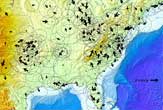
North America isn't exactly coming apart. But it is constantly on the move, and the latest discovery of geologic creep has surprised scientists.
During the last Ice Age, large portions of North America were blanketed by giant glaciers. Although they’ve been gone for more than 10,000 years, the land they once rested upon is still recovering from the weight.
Parts of North America and other continents are slowly rising due to an effect called post-glacial rebound. That much geologists knew.
But it turns out this slow recovery is also causing a very small horizontal shift, said Eric Calais, a geophysicist at Purdue University in Indiana. The movement varies from one spot to another, but the overall effect amounts to a 1-millimeter shortening per year of the distance between Florida and the Hudson Bay in northeastern Canada. That's about an inch every 25 years.
The shift is small potatoes compared to what goes on in the West.
The San Andreas Fault, which runs north-south, slips about 2 inches (5 centimeters) every year, causing Los Angeles to move towards San Francisco. Scientists forecast the cities will merge in about 15 million years. This relatively rapid change occurs at a plate boundary, where giant chunks of Earth's crust collide.
The area in Calais' study involves no plate boundaries. So the southward movement of the Northeast might represent a challenge to the conventional theory that the region's rocky crustal plate is totally rigid.
Sign up for the Live Science daily newsletter now
Get the world’s most fascinating discoveries delivered straight to your inbox.
Lucky discovery
Calais and his colleagues were trying to measure the effects of post-glacial rebound in a stretch of land between southeastern Missouri and Memphis, Tennessee called the New Madrid Seismic Zone, an area rocked by three great earthquakes in the early 1800s. Previous studies reported evidence of deformations due to post-glacial rebound in this region. But Calais' team did not.
As part of the investigation, however, they compared data from the New Madrid area with the rest of North America.
"As we analyzed the entire North American continent, we found this other signal related to post-glacial rebound that we had not anticipated," Calais told LiveScience.
The horizontal shifting is similar to gently pushing a balloon into a ceiling. Because the balloon can't rise any higher, it expands sideways.
The finding, based on data from the Global Positioning System, is detailed in the Dec. 15 issue of the journal Nature.
Related to earthquakes?
Compared to California, geologic activity east of the Rockies is tame. But significant earthquakes do occur.
Researchers have warned repeatedly in recent years that the New Madrid zone will eventually produce another devastating quake in what is now a highly populated region.
"If you look at the geological records, you can see there have been other events of similar magnitudes that have occurred approximately every 500 years or so, going back maybe 2000-3000 years," said Glen Mattioli, a geophysicist at the University of Arkansas involved in the study. "So it's that combination of things that gives rise to the idea that we could have another event of some magnitude that is undetermined."
Geologists expect an eventual earthquake in the New Madrid zone as strong as magnitude-8.
"A magnitude-7 today in that area would do a lot of damage because a lot of the structures weren't built to withstand earthquakes of that magnitude," Mattioli said in a telephone interview. "We have a lot of old structures, especially in Memphis and St. Louis, where there's a lot of unreinforced masonry structures."
Even New York and other parts of the Northeast have experienced damaging temblors in the past. A magnitude-5.0 quake in 1737, for example, knocked down chimneys in New York City and was felt from Boston to Philadelphia.
The researchers have pondered whether the horizontal motion they've detected has anything to do with any of these earthquakes. Calais and his colleagues are not ready to make a connection, however.
"It is a relatively slow motion, and it's too soon to say whether it affects fault lines far away in Missouri or anywhere else for that matter," he said.









